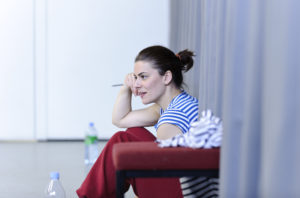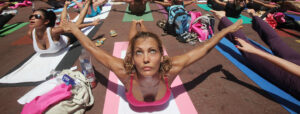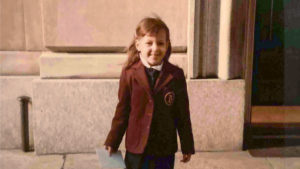I was a quiet, nervous little girl who didn’t much like the chaos of life. I could escape that, though, in the safety and discipline of the dance studio. With hair scraped back and uniform strict, the daily repetitions of mastering movement were profoundly reassuring. And my dreams were of a life of dance.
A ballet career, however, is a gruelling one, and all dancers, particularly female ones, face the constant impossibility of fulfilling that dream. From a very young age and at each step along the way, we are picked out or cast aside; we are encouraged or not; given attention or ignored; we land our perfect role or our names are left off the cast lists. We must sacrifice everything for dance.
The constant sense of competition, the impossible physical standards and punishing hours can be a source of anxiety and distress. But here is the inherent contradiction: it is the dance — the movement, the music, the choreography — which is also a salve for these emotions.
Dance was the love of Alice Robb’s life, but then it abandoned her. In her new book, Don’t think dear: On loving and leaving ballet, she brings that sense of competition to life. She describes dance as though it were an abusive lover: one that consumed her every waking moment, her body, mind and soul, only to walk out on her. And she never quite recovered. Sadly, her focus in the book is on the leaving, not the staying.
Her choice of title rather gives the game away. It refers to the “genius of ballet” George Balanchine, who ruled the aesthetic of the US style of ballet for a long period and is still worshipped today. Balanchine created and adored the svelte, skinny lines of the modern ballerina. “In my ballets, women are first,” he would say. And he created astonishing roles for his chosen few. The irony was that he did this by exerting overwhelming control over women, always patronisingly commanding: “Don’t think dear!” In other words: do as you are told. Don’t question, don’t ask, don’t you dare to think.
There are distinct parallels, which Robb sketches out, between Balanchine’s behaviour and the abuses of the modern ballet masters during our #MeToo era. Balanchine’s muse Carol Sumner jokes how Mr B “was very grabby” and would “be arrested today”, yet insists she is “on Mr B’s side”. Her joking hides the brutal aesthetic Balanchine brought in: no dancer could ever be too thin. “I want to see bones,” he said. Dancer Gelsey Kirkland describes living with an eating disorder, the inevitable side effect of his “concentration camp aesthetic”.
There is a dark, parasitic corner of the ballet world that Robb began to be trapped within. The part which feeds off a female dancer’s insecurities over her size, her height and her weight — never mind her abilities as a dancer.
Robb talks at length about the pressures so many dancers feel to be the right shape. They are told to lengthen, to stretch out — all euphemisms for: “lose weight”. And she describes, brutally, how women at her school who outgrew the recommended size or could not sustain a well-below-average body weight would not make the cut. Reading, I wondered, was the same about to happen to her?
What really interests me in Robb’s account of dancing is how she exposes a dancer’s physical pain. And the central contradiction of that: what pain means in a world where women still punish themselves and their bodies, in a profession that values this punishment while also appearing to be the height of beauty, elegance and grace. From the descriptions of learning to deal with the pain of pointe shoes, which brought back vivid memories of pouring surgical spirit over raw toes, to what it feels like being man-handled by men from a young age, to the wonderful fact that the force of balancing en pointe is the equivalent to letting the full weight of a grand piano fall on a single toe. All the while she — we — learned never to scream or cry.
The pain of performing while sick, while injured, while heartbroken becomes part of the dancer’s legend. We immortalise and mythologise our worst moments. There was the time I performed with pneumonia, each breath rasping, but still got to the end (weeks in bed was my punishment but returning to work, I was praised for my skinny frame); or the time a physio told me he could not let me dance, but I did anyway, three weeks post full knee reconstruction. The sacrifice, the dying for your art that is part of the culture of dance, is not for the faint-hearted. Add to that a culture of disordered eating, and the pain and sacrifice only ends in tears.
We see that culture everywhere today. I understand how dance exerts its power over young women and appeals to their sense of pain, freedom and sacrifice. I see, too, how dance enables women to escape that sense of being trapped in an imperfect body. To truly be a great dancer one becomes more than one’s body.
But while modern women navigate a world that is still so preoccupied with submission, compliance and pain, the female dancer, in Robb’s eyes, seems to at least be honest with their embrace of masochistic tendencies; they are able to accept that both physical and emotional pain is a prerequisite for dancing. So while we dancers suffer, we know we are doing it for a higher purpose. Robb’s assessment is that the modern woman is in denial. She is “post-wounded”, a term created by Leslie Jamison. She has adopted a stance of numbness or sarcasm. She “conducts herself as if pre-empting certain accusations: don’t cry too loud, don’t play victim, don’t act the old role all over again”. I can identify with this. The idea that no matter how awful, no matter how terrible or traumatic or painful an experience, a woman can never, ever “act the victim”.
But is this where modern feminism has brought us? To a place where we have to deny that we have struggled and suffered to take control of our lives and our bodies and the world we live in. In this post-wounded, post-vulnerable world, is it no longer acceptable to expose our pain? There is a generational difference here that Robb does hint at. It is sometimes only by exposing our pain as women that we can come together to say “no we need this — this is important to us”, which makes women of a post-wounded generation simply cringe and recoil. “We are not like the other women, we can handle our pain,” they say, a stance which might not be as helpful or progressive as they realise.
Missing from the book, tellingly perhaps, are the stories of women who have truly succeeded in dance, those who have found creative freedom and choice within these strict confines. This may be born of Robb’s relationship with the artform — she was not able to continue her career. Having rejected ballet and embraced modern dance, I was lucky enough to be inspired by a plethora of strong, independent and pioneering female artists, from Martha Graham and Doris Humphreys to Isadora Duncan and Pina Bausch. Women who created their own style, substance and companies, and gave life to their view of the world material through dance.
What about Robb? I was delighted by her description of the final moments of the dancer Anna Pavlova: her last words were “Get my swan costume ready”. The epitome of the show must go on. Then, in the next paragraph, Robb destroys her legacy, comparing Pavlova’s low legs and poor technique to that of a teenage amateur.
Did Robb miss out on female mentors along the way, I wondered? Was the gaze and award-giver only a man? Did she judge all other women by some impossible standards a man had bestowed on her? Where is the joy, I wondered. Was she never able to escape that bitterly critical voice inside herself and actually dance for her own reward?
It was this aspect of Robb’s examination — that of the somewhat expelled, rejected dancer which ended up being too strong for me. To be an independent voice, a female voice in dance, you need to have almost reached the point of giving up, and when you return, you play it by your own rules. That can be difficult to carry, and it can sometimes be lonely; you forge your own path, and by very definition you are no longer “the good girl”.
But Robb, the spurned dancer, can only hint at what she is still seeking. Comparing a ballet class to an exercise class, she laments the abstraction of the vocabulary of the gym compared with the beautiful vocabulary of ballet. In the gym you feel your “abs” and “quads”, in the studio you can be lifting your leg with an imaginary silver thread, expanding your arms like wings and being supported by the air around you. No mention of the muscles involved — simply an instruction and whisper of visual imagery and close attention to the detail of the movement.
This felt familiar: she knows the dancer’s world of imagination and visualisation, where we are free to conjure beauty and truth with our bodies. Deep down, Robb understands that dancers are not machines; we do not dance for punishment, we dance for love.
Rosie Kay’s 5 SOLDIERS is touring nationally
Disclaimer
Some of the posts we share are controversial and we do not necessarily agree with them in the whole extend. Sometimes we agree with the content or part of it but we do not agree with the narration or language. Nevertheless we find them somehow interesting, valuable and/or informative or we share them, because we strongly believe in freedom of speech, free press and journalism. We strongly encourage you to have a critical approach to all the content, do your own research and analysis to build your own opinion.
We would be glad to have your feedback.
Source: UnHerd Read the original article here: https://unherd.com/




